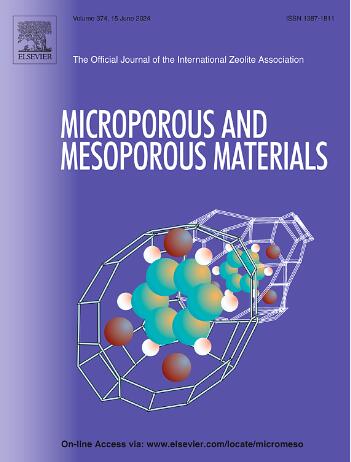Amorphousness matters: Its role on nonpolar gas diffusion at the nanoscale
IF 4.8
3区 材料科学
Q1 CHEMISTRY, APPLIED
引用次数: 0
Abstract
Amorphous carbon materials (ACM) produced using biomass waste feedstocks, offers an affordable, large-scale, and environmentally friendly production method. Their inherent porosity critically impacts gas diffusion and various applications, including gas separation, purification, and catalysis. This work determines, through molecular dynamics simulations, the effect of amorphicity on the diffusion of pure oxygen and methane, their 50% mixture and a 50% mixture of methane and carbon dioxide. For pure systems, we compare ACM with pores of similar size and regular shapes, such as slit pores and carbon nanotubes, with and without surface roughness. From the analysis of diffusion trajectories we find that molecular mobility decreases as the surface structural constrictions increase, configuring a more intricate molecular path for the gas to surface-diffuse. Specifically, constrictions imposed by the carbon surface structure increase in the next order: smooth surfaces, rough CNTs and ACMs. For ACM with a pore diameter of 1.5 nm, gas diffusion decreased by up to 95%. Notably, oxygen was trapped in surface defects (“pockets”) for both pure oxygen and its mixture with methane. The effects of pressure and temperature on the dynamic behavior of mixtures were also explored. For the 50% mixture of carbon dioxide and methane, we observed that in ACM with the smallest pore size, the relative diffusion is reduced by around 50% compared to bulk. Our findings suggest that amorphous materials could be preferred for devices that require high selectivity between gas mixtures due to their specific porous structure.

求助全文
约1分钟内获得全文
求助全文
来源期刊

Microporous and Mesoporous Materials
化学-材料科学:综合
CiteScore
10.70
自引率
5.80%
发文量
649
审稿时长
26 days
期刊介绍:
Microporous and Mesoporous Materials covers novel and significant aspects of porous solids classified as either microporous (pore size up to 2 nm) or mesoporous (pore size 2 to 50 nm). The porosity should have a specific impact on the material properties or application. Typical examples are zeolites and zeolite-like materials, pillared materials, clathrasils and clathrates, carbon molecular sieves, ordered mesoporous materials, organic/inorganic porous hybrid materials, or porous metal oxides. Both natural and synthetic porous materials are within the scope of the journal.
Topics which are particularly of interest include:
All aspects of natural microporous and mesoporous solids
The synthesis of crystalline or amorphous porous materials
The physico-chemical characterization of microporous and mesoporous solids, especially spectroscopic and microscopic
The modification of microporous and mesoporous solids, for example by ion exchange or solid-state reactions
All topics related to diffusion of mobile species in the pores of microporous and mesoporous materials
Adsorption (and other separation techniques) using microporous or mesoporous adsorbents
Catalysis by microporous and mesoporous materials
Host/guest interactions
Theoretical chemistry and modelling of host/guest interactions
All topics related to the application of microporous and mesoporous materials in industrial catalysis, separation technology, environmental protection, electrochemistry, membranes, sensors, optical devices, etc.
 求助内容:
求助内容: 应助结果提醒方式:
应助结果提醒方式:


